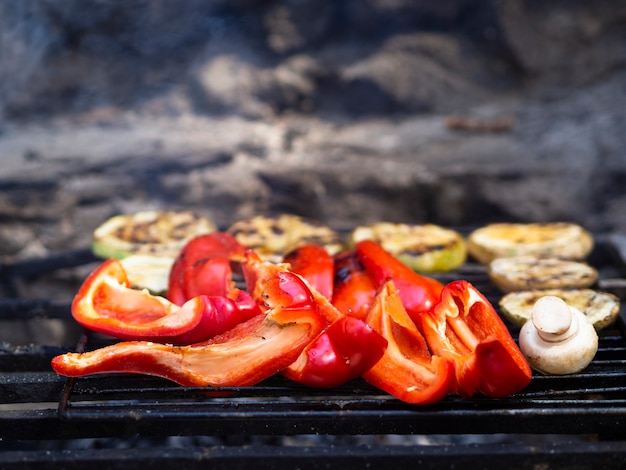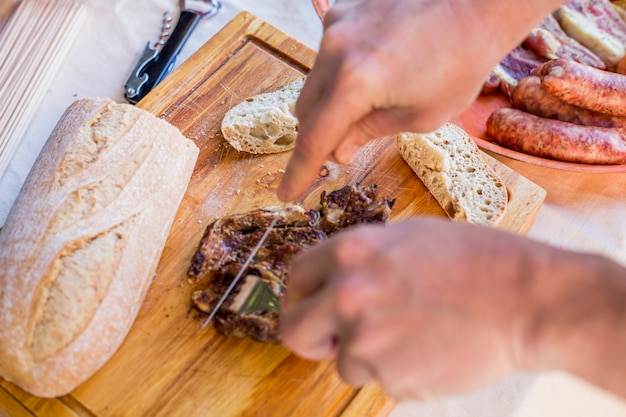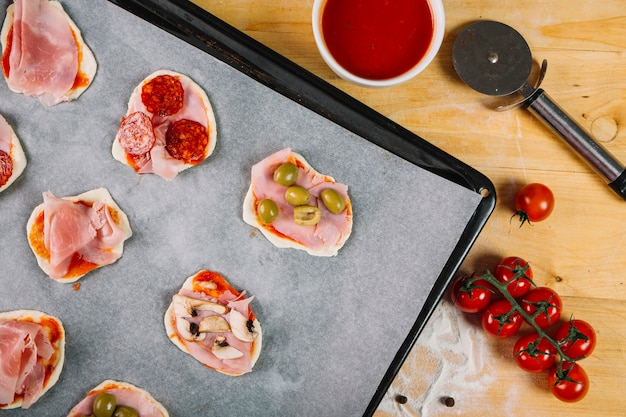Alright, let's talk bacon! Crispy, salty, smoky - it's the undisputed king of breakfast, the star of a good brunch, and the perfect topping for any meal. And for me, there's nothing quite like the satisfaction of perfectly cooked oven-baked bacon. You know, that kind where the fat renders beautifully, leaving you with those gloriously crispy edges and a tender, juicy center.
But, as any seasoned bacon enthusiast knows, getting that perfect bite requires a bit of know-how. It’s not just about tossing some rashers into the oven and hoping for the best. There’s a science to it, my friends! Over the years, I've been on a quest to find the ultimate oven-baked bacon recipe, and I've learned a few things along the way. I’m going to share everything I’ve discovered with you, from temperature guides to tips and tricks, so you can master the art of the perfect oven-baked bacon. Buckle up, it's going to be a tasty journey!
(Part 1) The Basics: Why Oven-Baked Bacon Wins

A Love Affair with Oven-Baked Bacon
First off, let me tell you why I'm such a huge fan of oven-baked bacon. It's simple, really. It's a hands-off, fuss-free way to cook bacon, perfect for those busy mornings when you're just trying to get out the door. Plus, you can cook a whole lot of bacon at once, making it ideal for a crowd. No more crowding the pan or battling with splatter – it's a game-changer!
But here's the real kicker - oven-baked bacon cooks more evenly than pan-fried bacon. You'll get those crispy edges we all crave, without having to flip each rasher halfway through. It’s a little bit of culinary magic, if you ask me.
(Part 2) The Temperature Guide: Finding Your Sweet Spot

The Golden Rule: Lower and Slower
Now, let's dive into the temperature game. Remember, the key to perfect oven-baked bacon is low and slow. Forget the scorching hot oven – you want to gently cook the bacon until the fat renders beautifully, leaving you with that irresistible crunch.
The Science Behind the Perfect Temperature
Why lower temperatures? Well, it all comes down to science. Lower temperatures allow the fat to render more evenly, resulting in crispy edges and a juicy centre. If you crank up the heat, you risk burning the bacon before the fat has a chance to melt. Trust me, nobody wants burnt bacon.
The Sweet Spot: My Recommended Temperatures
So, what’s the perfect temperature for oven-baked bacon? Well, I find that a temperature range of 350°F (175°C) to 400°F (200°C) works like a charm. It's a sweet spot that allows the fat to render beautifully while keeping the bacon from drying out.
Temperature Variations: Adjusting for Thickness
However, you might need to adjust the temperature slightly depending on the thickness of your bacon. For thinner slices, a lower temperature might be more suitable, while thicker cuts might benefit from a slightly higher heat.
(Part 3) Setting the Stage: The Right Tools for the Job

The Oven Rack: Where the Magic Happens
Now, let’s talk about setting the stage. You’ll need a good oven rack for this. I recommend using a wire rack placed over a baking sheet to catch all that delicious bacon fat. It allows for air circulation, which helps the bacon cook evenly and prevents it from steaming.
Choosing the Right Rack: Wire vs. Cooling
There are two types of oven racks that work well for baking bacon: wire racks and cooling racks. Both provide excellent air circulation, but I personally prefer a wire rack, as it offers more surface area for the bacon to crisp up. Cooling racks can be a bit more delicate and might not be as sturdy for holding a full load of bacon.
The Baking Sheet: A Crucial Ally
And don’t forget about your baking sheet. It’s there to keep the bacon fat from dripping all over your oven. Use a large enough sheet to accommodate all your bacon rashers without them touching. You want to give them space to breathe and crisp up beautifully.
The Fat: A Flavorful Sidekick
Lastly, the fat. It’s not just about the deliciousness – it’s the key to getting that crispy texture we all adore. But, you can control the amount of fat, and that’s where choosing the right type of bacon comes into play.
(Part 4) Bacon Choices: From Thin to Thick, From Smoky to Sweet
The Thin and Crispy: Perfect for a Quick Bite
Let’s talk about bacon choices. You’ve got your thin-sliced bacon, which cooks up quickly and is perfect for a quick bite. It’s ideal for those days when you’re short on time, but still want that delicious crispy texture.
The Thick and Chewy: A Feast for the Senses
Then there’s the thick-cut bacon. It’s more substantial, with a chewier texture and a more intense flavour. It takes a little longer to cook, but it’s worth the wait. It’s perfect for those wanting a more decadent bacon experience.
The Smoky and Savory: A Flavorful Adventure
And, of course, you have a variety of flavours to choose from. You’ve got your classic smoky bacon, which is always a crowd-pleaser. But if you’re feeling adventurous, there are also maple-smoked, peppered, and even applewood-smoked bacons. It’s all about personal preference!
The Unconventional: Exploring Alternative Bacon Choices
And if you're looking for something a bit different, you can even find turkey bacon or plant-based bacon alternatives, which can offer a healthier option without sacrificing too much flavor.
(Part 5) The Art of Arranging: Mastering the Layout
The Single-Layer Approach: Maximizing Crispness
Now, let’s talk about the art of arranging your bacon. You want to make sure you’re not overcrowding the baking sheet. The general rule is to arrange the bacon in a single layer, with a little space between each rasher. This allows for even cooking and helps create that lovely crispy texture.
Spacing is Key: Giving Bacon Room to Breathe
If you’re working with a large amount of bacon, you might need to use two baking sheets. Remember, you want to give those rashers room to breathe.
The Overlap Method: An Alternative for Crispness
Some people prefer to overlap their bacon slightly, as this helps create a more even cooking surface. However, I find that the single-layer approach generally results in crispier bacon.
(Part 6) cooking time: The Telltale Signs of Perfection
The Time Factor: A Rough Guide
Now, let’s talk cooking time. It all depends on the thickness of your bacon and the desired level of crispness. A good rule of thumb is to start with 15-20 minutes for thin-sliced bacon and 20-25 minutes for thick-cut bacon.
The Telltale Signs: Don’t Be Afraid to Peek
But the best way to tell if your bacon is cooked to perfection is to keep an eye on it. You’re looking for those golden-brown edges, a slight curl at the edges, and a little bit of fat rendering out. Don’t be afraid to peek every few minutes to check on its progress.
The Flip Side: For Even Crispness
If you want to make sure your bacon cooks evenly, you can flip it halfway through the cooking time. Just be careful not to touch the bacon too much as this can cause it to stick to the baking sheet.
The Importance of Patience: Waiting for the Magic
The key here is patience. Don't rush the process. Let the bacon cook slowly and evenly. You'll be rewarded with a delicious, perfectly cooked result.
(Part 7) Beyond the Basics: Taking Bacon to the Next Level
The Sweet and Savory: A Touch of Glaze
Now, let’s spice things up! If you’re feeling adventurous, you can add a touch of sweetness or spice to your bacon. Try brushing it with a maple syrup glaze or a spicy honey mustard sauce. It’ll add another dimension of flavour to your bacon.
The Herb Infusion: A Burst of Freshness
For a fresh, herbaceous flavour, try sprinkling your bacon with herbs like rosemary, thyme, or sage before baking. Just be sure not to overdo it, as you want the bacon flavour to shine through.
The Spice Rub: A Flavorful Adventure
Want to add a bit of heat? Try rubbing your bacon with a spice blend like cayenne pepper, paprika, or chili powder. Just a pinch will add a nice kick to your bacon.
The Sweet and Smoky: Combining Flavors for a Unique Experience
For a truly unique bacon experience, try combining a sweet and smoky glaze, like maple syrup with a hint of smoked paprika. It will create a complex flavour profile that will tantalize your taste buds.
(Part 8) The Rest and Relaxation: Allowing the Bacon to Cool
Letting the Bacon Settle: A Cool Down for Crispness
Once your bacon is cooked to perfection, it's important to let it cool on a wire rack for a few minutes. This will allow the fat to solidify and the bacon to become nice and crispy.
The Fat: Don’t Waste It!
And don’t throw away that bacon fat! It’s a flavour bomb waiting to be used. You can use it to fry eggs, make popcorn, or even add it to your next batch of beans.
Storing Bacon Fat: Making the Most of It
To store bacon fat, simply pour it into an airtight container and refrigerate it. It can last for several months.
(Part 9) Serving Up Your Masterpiece: The Delicious Aftermath
The Crispy Crunch: A Taste of Heaven
Now, the moment of truth – it's time to enjoy your masterpiece! Grab yourself a piece of that perfectly cooked bacon. Take a bite. Let the crispness explode in your mouth. You deserve it!
Bacon Inspiration: Endless Possibilities
And what’s great is that oven-baked bacon is so versatile. You can add it to salads, burgers, sandwiches, or even pasta dishes. The possibilities are endless!
Bacon Beyond the Plate: Getting Creative
Don't be afraid to experiment and get creative with your bacon. You can crumble it into a salad, use it as a topping for a baked potato, or even add it to your favorite pizza.
FAQs
What if my bacon is sticking to the baking sheet?
If your bacon is sticking to the baking sheet, try using a non-stick baking sheet or lightly greasing the sheet with cooking spray. You can also try flipping the bacon halfway through the cooking time to help prevent sticking.
Can I cook frozen bacon in the oven?
You can cook frozen bacon in the oven, but it will take a little longer. Be sure to increase the cooking time by about 5-10 minutes.
How do I store leftover bacon?
Store leftover bacon in an airtight container in the refrigerator for up to 4 days. You can also freeze bacon for up to 3 months.
What if my bacon is too crispy?
If your bacon is too crispy, try reducing the cooking time next time. You can also try cooking it at a lower temperature.
What can I do with bacon grease?
Bacon grease is a versatile ingredient! It can be used for frying, baking, or even adding flavour to soups and stews. You can also use it to make popcorn, add a smoky flavour to your beans, or even use it as a base for a homemade gravy.
So there you have it, my friends! With these tips and tricks, you’ll be well on your way to mastering the art of the perfect oven-baked bacon. It’s a journey of discovery, experimentation, and pure bacon bliss. Happy cooking!
Everyone is watching

How to Cook Frozen Lobster Tails Perfectly: A Step-by-Step Guide
RecipesLobster. Just the word conjures up images of lavish meals, special occasions, and a taste of luxury. But let's...

Pigs in a Blanket Cooking Time: How Long to Bake for Perfect Results
RecipesAh, pigs in a blanket. Just the name conjures up images of those delightful little parcels of crispy pastry en...

Pork Fillet Cooking Time: How Long to Cook It Perfectly
RecipesPork fillet, or tenderloin as it's sometimes called, is a real favourite in our house. It's so versatile, and...

The Ultimate Guide to Tender, Juicy Pulled Pork
RecipesRight, let's talk pulled pork. It's one of those dishes that just screams "comfort food," doesn't it? I mean...

The Ultimate Guide to Cooking Sweet Potatoes: From Roasting to Mashing
RecipesSweet potatoes. Just the name conjures up images of warm, comforting dishes, bursts of vibrant color, and a to...
